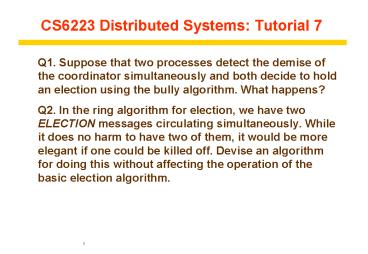CS6223 Distributed Systems: Tutorial 7 - PowerPoint PPT Presentation
1 / 8
Title:
CS6223 Distributed Systems: Tutorial 7
Description:
A distributed system may have multiple, independent critical regions. ... For example, if the process has printed some output, the ink cannot be removed ... – PowerPoint PPT presentation
Number of Views:90
Avg rating:3.0/5.0
Title: CS6223 Distributed Systems: Tutorial 7
1
CS6223 Distributed Systems Tutorial 7
- Q1. Suppose that two processes detect the demise
of the coordinator simultaneously and both decide
to hold an election using the bully algorithm.
What happens? - Q2. In the ring algorithm for election, we have
two ELECTION messages circulating simultaneously.
While it does no harm to have two of them, it
would be more elegant if one could be killed off.
Devise an algorithm for doing this without
affecting the operation of the basic election
algorithm.
2
CS6223 Distributed Systems Tutorial 7
- Q3. In the centralized approach to mutual
exclusion, upon receiving a message from a
process releasing its exclusive access to the
critical region it was using, the coordinator
normally grants permission to the first process
on the queue. Give another possible algorithm for
the coordinator. - Q4. Consider the algorithm in Q3 again. Suppose
that the coordinator crashes. Does this always
bring the system down? If not, under what
circumstances does this happen? Is there any way
to avoid the problem and make the system able to
tolerate coordinator crashes?
3
CS6223 Distributed Systems Tutorial 7
- Q5. A distributed system may have multiple,
independent critical regions. Imagine that
process 0 wants to enter critical region A and
process 1 wants to enter critical region B. Can
the distributed algorithm for mutual exclusion
(given in the lecture) lead to deadlocks? Explain
your answer. - Q6. We have repeatedly said that when a
transaction is aborted, the world is restored to
its previous state, as though the transaction had
never happened. We lied. Give an example where
resetting the world is impossible.
4
Tutorial 7 Q1 Q2 Ans.
- Q1 Ans.
- In such a case, each of the higher-numbered
processes will get two ELECTION messages, but
will ignore the second one. The election will
proceed as usual. - Q2 Ans.
- When a process receives an ELECTION message, it
checks to see who started it. If it itself
started it (i.e., its number is at the head of
the list), it turns the message into a
COORDINATOR message as described in the text. If
it did not start any ELECTION message, it adds
its process number and forwards it along the
ring.
5
Tutorial 7 Q2 Ans. (Continued)
- However, if it did send its own ELECTION
message earlier and it has just discovered a
competitor, it compares the originators process
number with its own. If the other process has a
lower number, it discards the message instead of
passing it on. If the competitor is higher, the
message is forwarded in the usual way. In this
way, if multiple ELECTION messages are started,
the one whose first entry is highest survives.
The rest are killed off along the route.
6
Tutorial 7 Q3 Q4 Ans.
- Q3 Ans.
- Requests could be associated with priority
levels, depending on their importance. The
coordinator could then grant the highest priority
request first. - Q4 Ans.
- Suppose that the algorithm is that every
request is answered immediately, either with
permission or with denial. If there are no
processes in critical regions and no processes
queued, then a crash is not fatal. The next
process to request permission will fail to get
any reply at all, and can initiate the election
of a new coordinator. The system can be made even
more robust by having the coordinator store every
incoming request on disk before sending back a
reply. In this way, in the event of a crash, the
new coordinator can reconstruct the list of
active critical regions and the queue by reading
file from the disk.
7
Tutorial 7 Q5 Ans.
- Q5 Ans.
- It depends on the ground rules. If processes
enter critical regions strictly sequentially,
that is, a process in a critical region may not
attempt to enter another one, then there is no
way that it can block while holding a resource
(i.e., a critical section) that some other
process wants. The system is then deadlock free.
On the other hand, if process 0 may enter
critical region A and then try to enter critical
region B, a deadlock can occur if some other
process tries to acquire them in the reverse
order. The distributed algorithm for mutual
exclusion itself does not contribute to deadlock
since each critical region is handled
independently of all the others.
8
Tutorial 7 Q6 Ans.
- Q6 Ans.
- Any situation in which physical I/O has occurred
cannot be reset. For example, if the process has
printed some output, the ink cannot be removed
from the paper. Also, in a system that controls
any kind of industrial process, it is usually
impossible to undo work that has been done.































